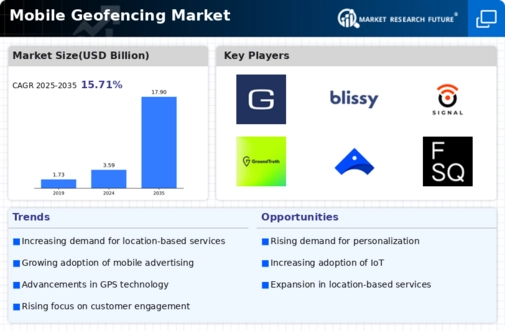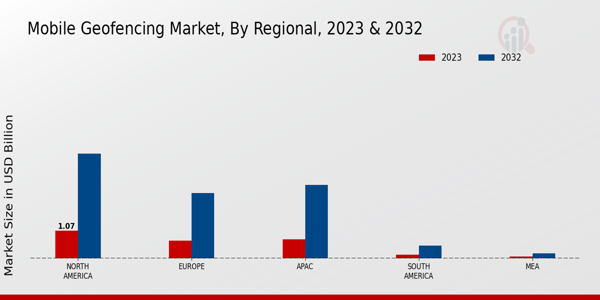Market Growth Projections
The Global Mobile Geofencing Market Industry is projected to experience substantial growth in the coming years. With an estimated market value of 3.59 USD Billion in 2024, the industry is on a trajectory to reach 17.9 USD Billion by 2035. This growth reflects a compound annual growth rate (CAGR) of 15.71% from 2025 to 2035. Such projections indicate a robust demand for geofencing solutions across various sectors, driven by technological advancements and increasing consumer expectations for personalized experiences. The market's expansion is likely to attract new players and foster innovation, further enhancing its competitive landscape.
Integration with IoT Devices
The integration of geofencing technology with Internet of Things (IoT) devices is emerging as a key driver for the Global Mobile Geofencing Market Industry. As IoT devices proliferate, the ability to create geofences around connected devices opens new avenues for businesses. For example, smart home devices can trigger actions based on the user's location, enhancing convenience and security. This integration allows for more sophisticated applications in various sectors, including automotive and healthcare. As the IoT ecosystem continues to expand, the synergy between geofencing and IoT is likely to foster innovative solutions, further driving market growth.
Growth in Mobile Device Usage
The proliferation of mobile devices globally significantly contributes to the expansion of the Global Mobile Geofencing Market Industry. With billions of smartphones in use, businesses are increasingly targeting consumers through mobile applications that incorporate geofencing capabilities. This trend is particularly evident in sectors such as retail and hospitality, where personalized marketing can lead to higher conversion rates. The ease of access to geofencing technology on mobile platforms allows companies to implement location-based strategies effectively. As mobile device penetration continues to rise, the market is poised for substantial growth, potentially reaching 17.9 USD Billion by 2035.
Rising Demand for Personalized Marketing
The Global Mobile Geofencing Market Industry is significantly influenced by the rising demand for personalized marketing strategies. Consumers increasingly expect tailored experiences, and geofencing provides businesses with the tools to deliver such offerings. By utilizing geofencing, companies can send targeted promotions and notifications to users based on their real-time location, enhancing customer engagement. This trend is particularly prevalent in the retail sector, where personalized marketing can lead to increased sales and customer satisfaction. As businesses recognize the value of personalized interactions, the adoption of geofencing technology is expected to grow, contributing to a projected CAGR of 15.71% from 2025 to 2035.
Advancements in GPS and Location Technologies
Technological advancements in GPS and location services play a crucial role in driving the Global Mobile Geofencing Market Industry. Enhanced accuracy and reliability of location data enable businesses to create more effective geofencing strategies. Innovations such as real-time tracking and improved mapping technologies allow for precise targeting of consumers based on their location. This capability is particularly beneficial for industries like logistics and transportation, where timely information is essential. As these technologies evolve, they are likely to attract more businesses to adopt geofencing solutions, further propelling market growth.
Increasing Adoption of Location-Based Services
The Global Mobile Geofencing Market Industry experiences a surge in demand due to the increasing adoption of location-based services across various sectors. Businesses are leveraging geofencing technology to enhance customer engagement and improve marketing strategies. For instance, retailers utilize geofencing to send promotional offers to customers' smartphones when they enter a defined geographic area. This approach not only boosts foot traffic but also fosters brand loyalty. As of 2024, the market is valued at 3.59 USD Billion, indicating a robust growth trajectory as companies recognize the potential of location-based marketing.






















